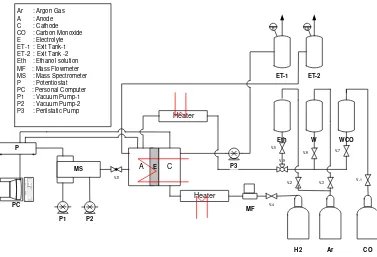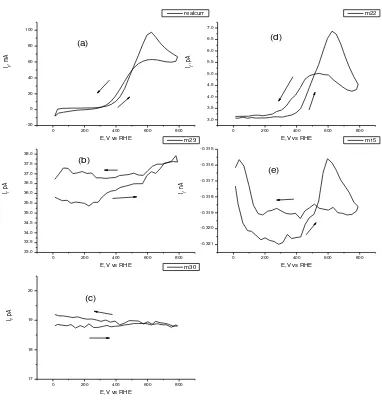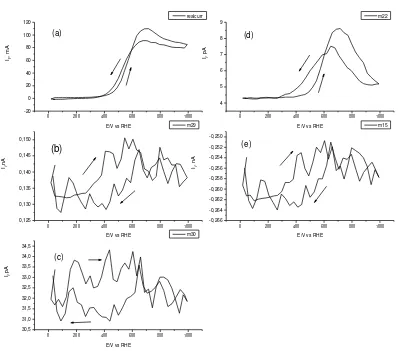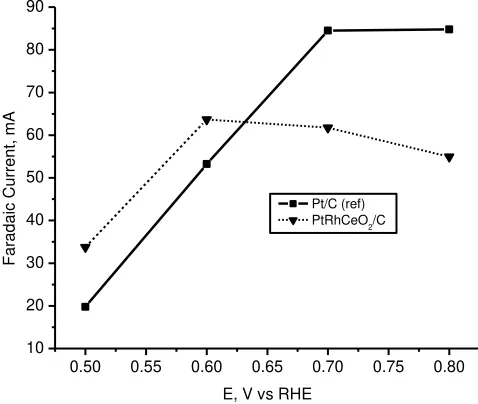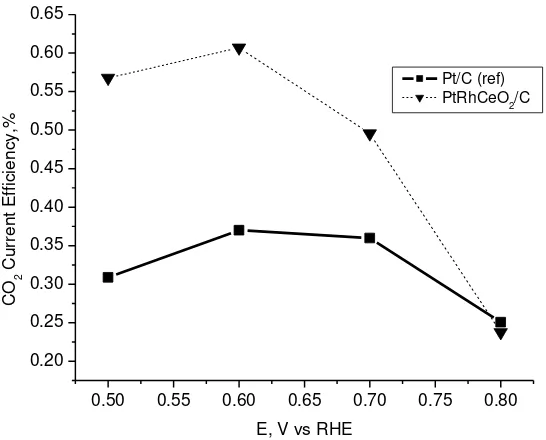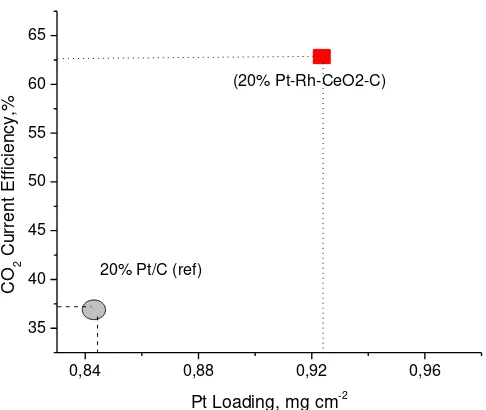IN-SITU CO
2CURRENT EFFICIENCY MEASUREMENT OF
DIRECT ETHANOL FUEL CELL
Hariyanto1, Vineet Rao2
1
Balai Besar Teknologi Energi (B2TE), Puspiptek Serpong 15314 Tangerang-Indonesia e-mail: hariyanto_b2te@webmail.bppt.go.id
2
Interface and Energy Conversion Group (E-19)- Physics Department Technical University of Munich, D85478 Munich-Germany
ABSTRACT
In this present work, we carry out systematically study on catalyst for ethanol electrooxidation in direct ethanol fuel cell. For cathode catalyst we use a commercial catalyst of 40% Pt/C from ETEK. Catalysts were printed on to carbon paper of TGPH 060 and sandwiched into membrane electrode
assembly (MEA) and then arranged in fuel cell with the geometric area 1.2 cm2. As an electrolyte, we
used Nafion 117 from Du Pont. On-line Differential Electrochemical Mass Spectrometry (DEMS) measurement in fuel cell setup was carried out in order to determine the activity and selectivity which
was indicated by result of Faradaic current and CO2 current efficiency of ethanol electro-oxidation
respectively. PtRhCeO2/C was significantly improve the selectivity to form of CO2 in comparison to
the commercial catalyst of 20% Pt/C from Alfa Aesar- Johnson Mattews . Increasing of selectivity is
shown by increase of CO2 current efficiency of ethanol oxidation of about 25 percent in comparison
to references catalyst of 20% Pt/C Alfa Aesar-JM
Key words: Membrane electrode assembly (MEA), DEMS, ethanol electro-oxidation
ABSTRAK
Pada penelitian ini dilakukan kajian sistematis terhadap katalis 20% PtRhCeO2/C pada fuel cell
dengan bahan bakar ethanol. Pada sisi katoda digunakan katalis komersial 40% Pt/C dari ETEK.
Katalis tersebut di cetak pada kertas karbon TGPH 060 dan dirangkai dalam membrane electrode
assembly (MEA) kemudian pasang dalam fuel cell dengan luasan geometrik 1,2 cm2. Sebagai
elektrolit digunakan Nafion 117 dari Du Pont. Pengukuran secara on-line dengan Differential
Electrochemical Mass Spectrometry (DEMS) dilakukan untuk mengetahui aktivitas dan selektivitas
katalis yang ditunjukkan dengan arus Faraday dan efisiensi arus CO2 dari reaksi elektrooksidasi yang
terjadi. Katalis PtRhCeO2/C terbukti meningkatkan selektivitas katalis menuju pembentukan CO2
dibandingkan dengan katalis komersial 20% Pt/C Alfa Aesar-Johnson Mattews. Peningkatan
selektivitas ditunjukkan dengan kenaikkan efisiensi arus CO2 pada elektro-oksidasi ethanol sebesar
25% dibanding dengan katalis rujukan 20% Pt/C Alfa Aesar-JM
Kata kunci: Membrane electrode assembly (MEA), DEMS, Elektro-oksidasi ethanol
1. INTRODUCTION
fuels which are investigated as a fuel of direct type fuel cell. Ethanol is one of them. It is well known that ethanol is not toxic for human and is easily produced from biomass. This means that carbon dioxide (CO2) emitted from direct type fuel cell using ethanol as a fuel can be recycled by planting. Ethanol as alternative fuel for direct ethanol fuel cell (DEFC) also has a relative high energy density (8 kwH/kg) and for comparison methanol energy density was 6 kWh/kg.
The case of oxidation of ethanol is more complicated than methanol which is necessity to break C-C bond to obtain the total oxidation reaction. To obtain this, it is necessary to modify the structure or composition of anode catalyst. Electrocatalytic oxidation of ethanol using platinum or platinum alloy catalyst has been investigated [1-3], and the products formed by the electrocatalytic oxidation of ethanol and the oxidation reactivity of ethanol were discussed from many aspects. Iwasita and Pastor studied the adsorb behavior of ethanol on a polycrystalline platinum using a differential electrochemical mass spectroscopy (DEMS) and FTIR [1]. They reported many adsorbed species formed by the oxidation of ethanol and observed the evolution of CO2.The aim of the present paper is to investigate the activity and selectivity of the PtRhCeO2/C catalyst for electrooxidation of ethanol. The result was compared to the commercial Pt/C catalyst from Alfa Aesar-Johnson Mattews.
2. EXPERIMENT
2.1. Membrane Electrode Assembly (MEA)
In this experiment we used 20% PtRhCeO2/C catalyst (prepared at Technical University of Munich) as anode catalyst and 20% Pt/C (Alfa Aesar - Johnson Matthew) as reference catalyst. As cathode catalyst is used 40% Pt/C (from ETEK). Catalyst ink was prepared by mixing the required amount of catalyst powder with 20 % Nafion solution (Du Pont) to give 30% wt. of Nafion, and then diluted with a mixture of millipore water and 2-propanol. The resulting ink then placed in an ultrasonic bath for 10 minutes or until the catalyst powder had fully dispersed. This ink then sprayed onto a piece of carbon Toray paper TGPH 060 which was kept at 110oC throughout the process, in order to assist the binding of the catalyst to the backing layer. The spraying machine consisted of motorised X-Y table controlled by a CNC automation controller. The catalyst layer on carbon paper then sandwiched into carbon paper to make-the membrane electrode assembly (MEA)
2.2. Description of DEMS Setup
anode outlet flow passes. This volume is separated from the vacuum system of the mass spectrometer by a Micro porous Teflon membrane (Schleicher & Schuell, TE-30) with a pore size of 0.02 micrometer and a thickness of 110 micrometer. The membrane is supported by a Teflon disc of 2 mm in diameter, with holes.
The fuel cell consisted of two stainless steel plates with integrated serpentine medium distribution channels. Six threaded studs and nuts held the two plates together. The fuel cell can be operated in both modes half-cell and full cell. Generally during the investigation of anode it is used as a half-cell. Cathode with Pt loading (2.5mg/cm2) and continuous hydrogen flow works as counter and reference both. Potential of the cathode is assumed to be same as of the reversible-hydrogen electrode (RHE). All potential are reported in reference to this. Schematic diagram of DEMS setup is shown in Fig.1.
H2 Ar CO
Fig. 1. Schematic diagram of DEMS setup
2.3. Calibration of DEMS System
DEMS measurement is because the mass number of both CO2 and CH3CHO is the same at 44 and to monitor both together is not possible at m/z= 44. To solve this problem, Fujiwara et al.[4],used deuterated ethanol (CD3CH2OH) for determining reaction products that had same mass number. Due to the high cost of this material, extensive utilization is limited. To avoid interference between CO2+ and CH3CHO+ ion current (both at m/z =44), which are the major ethanol electrooxidation products, carbon dioxide and acetaldehyde was monitored at m/z =22 and m/z =29 respectively. The calibration of DEMS for CO2 is performed with H2 oxidation current interference and potentiostatic bulk CO oxidation.
2.4. In-situ DEMS Measurement
Potentiodynamic Measurements: Cyclic Voltammogram and Mass Cyclic Voltammogram
for ion currents m/z =22, 29, 15 and 30 from 0 – 1.0 V vs RHE with scanrate 5 mV/s at temperature 90oC. Steady state voltammogram for ethanol electrooxidation was recorded after several cycles.
Potentiostatic DEMS Measurements: monitoring transient faradaic current and ion mass
current by stepping the potential from 0 V vs RHE to 0.5, 0.6, 0.7 ,and 0.8 V vs RHE ( 10 minutes for each potential step), with scanrate 5 mV/s at temperature 90oC for Cyclic Voltammogram and Mass Cyclic Cyclic Voltammogram for ion currents m/z =22, 29, 15 and 30.
3. RESULT AND DISCUSSION
3.1. Potentiodynamic Measurement
0 200 400 600 800
Fig. 2. CV and MSCV of 20% PtRhCeO2/C catalyst at temperature 90oC, ethanol
0 200 400 600 800 1000
Fig. 3. CV and MSCV of 20% Pt/C catalyst at temperature 90oC, ethanol flowrate 5
ml/min, with scanrate 5 mV/s(a) CV (b) MSCV for m/z = 29 (c) MSCV for m/z = 30 (d) MSCV for m/z = 22 and (e) mSCV for m/z = 15
3.2. Potentiostatic Measurement
Figure 4 shows the Faradaic current vs potential for different catalysts. Testing performance in DEMS is conducted at temperature 90 oC , 5 ml/minute ethanol flowrate, and with scanrate of 5 mV/s by potentiostatic measurements. This result indicated that Faradaic current of catalysts which added ceria provided higher current at low potential (up to 0.6 V) in comparison to Pt/C (Alfa Aesar-JM) catalyst reference. This means that by adding ceria on Pt-based catalyst could increase an activity of the catalysts at low potential, although this elevated in Faradaic current was not so high. In application of fuel cell, increase of Faradaic current at low potential is more useful compared to increase of Faradaic current at high potential. Therefore we want to further investigate increase of Faradaic current at the lower potential by analyzing of ion mass number 22 as shown in Fig.5
0.50 0.55 0.60 0.65 0.70 0.75 0.80
10 20 30 40 50 60 70 80 90
F
a
ra
d
a
ic
C
u
rre
n
t,
mA
E, V vs RHE
Pt/C (ref) PtRhCeO2/C
Fig. 4. Faradaic current vs. potential, at temperature 90oC, scanrate 5 mV/s, anode
catalyst loading 0.8 mg/cm2 for 20% PtRhCeO2/C (dashed line) and 20% Pt/C
Alfa Aesar-JM (solid line), cathode catalyst loading 2.5 mg/cm2 (20% Pt/C
ETEK)
catalyst. The role of ceria in the oxidation of carbon monoxide was agreed to what reported
0.50 0.55 0.60 0.65 0.70 0.75 0.80
0.20
Fig. 5. CO2 current efficiency vs. potential, at temperature 90oC, scanrate 5 mV/s,
anode catalyst loading 0.8 mg/cm2 for 20% PtRhCeO2/C (dashed line) and
20% Pt/C Alfa Aesar-JM (solid line), cathode catalyst loading 2.5 mg/cm2
(20% Pt/C ETEK)
0,84 0,88 0,92 0,96 35
40 45 50 55 60 65
20% Pt/C (ref)
(20% Pt-Rh-CeO2-C)
CO
2
C
urr
en
t
E
ff
ici
en
cy,
%
Pt Loading, mg cm-2
Fig. 6. CO2 current efficiency vs CO stripping charge for different catalysts at
potential 0.6 V, temperature 90oC, scan rate 5 mV/s, ethanol flowrate 5
ml/min
4. CONCLUSION
The product of the ethanol oxidation reaction over Pt/C and PtRhCeO2/C catalysts which investigated by in-situ DEMS were CO2, Acetaldehyde, methane, ethane, while acetic acid
couldn’t detect by DEMS due to its low volatility.
Performance comparison of DEMS measurement result between 20% PtRhCeO2/C and 20% Pt/C catalyst indicated that over PtRhCeO2/C catalyst provided higher activity than Pt/C which is indicated by increase on Faradaic current and provided higher selectivity of the catalysts which is indicated by increasing of CO2 current efficiency. Both increase of activity and selectivity were occurred at low potential (<= 0.6 V). Improvement of CO2 current efficiency of ethanol oxidation was about 25 % in comparison to references catalyst of 20% Pt/C Alfa Aesar-JM
REFERENCES
[1] Iwasita T., E. Pastor. Parallel Pathways of Ethanol Oxidation: The Effect of Ethanol
Concentration, Electrochim. Acta 39, 1994, pp. 531.
[2] G.A. Camara, R.B. de Lima, T. Iwasita. Catalysis of Ethanol Electrooxidation by
[3] N. Fujiwara, K.A. Friedrich, U. Stimming. Ethanol oxidation on PtRu Electrodes
Studied by Differential Electrochemical Mass Spectrometry, J. Electroanal. Chem.
472, 1999, pp. 120.
[4] Carsten Cremers, Hariyanto, V. Rao, A. Racs. Direct Ethanol Fuel Cells, Proceeding Workshop of TFI, Duissburg Germany, 2006.
[5] H. Wang, Z. Jusys, and R. J. Behm. Ethanol Electrooxidation on a Carbon-Supported
Pt Catalyst: Reaction Kinetics and Product Yields, J. Phys. Chem. B,2004, 108, pp.
19413-19424
[6] Thi X. T. Sayle, Stephen C. Parker and Dean C. Sayle, Phys. Chem. Chem. Phys., 2005 , 7 , pp. 2936 – 2941.
[7] Carl Hamann, Andrew Hamnet, Wolf Vielstich. Electrochemistry 2nd edition, Wiley CVH, 2007.
[8] Xia X. H.,H.D., Lies, T Iwasita. Early Stage in The Oxidation of Ethanol at Low
Index Single Crystal Platinum Electrode, J. Elec. Anal. Chem, 437, 1997, pp.
233-241.
[9] V. Rao, Hariyanto, Carsten Cremer, U.Stimming. DEMS Study on Alkaline Anion
Membrane Fuel Cell, Journal of Fuel Cells, 2007.
[10] Hariyanto, Widodo W. Purwanto. Ethanol Electro-oxidation on Pt Based Catalyst for
Direct Ethanol Fuel Cell, UNSRI, July 19-20, 2006.
[11] Carsten Cremmers, Hariyanto, V. Rao, A. Racs, U. Stimming. Direct Ethanol Fuel Cell, Proceeding TFI, 28-29 March, Duissburg, Germany, 2006, pp.327-332.
[12] Hariyanto, Carsten Cremers, U. Stimming. Ethanol Electro-oxidation on
